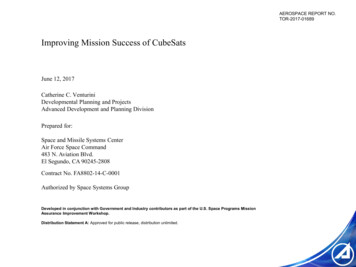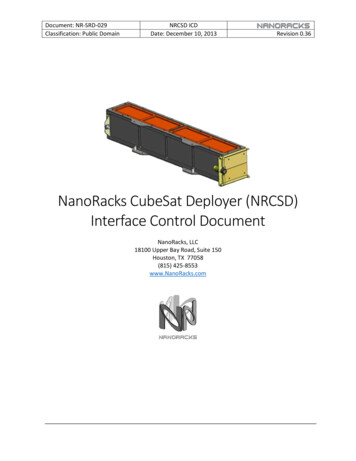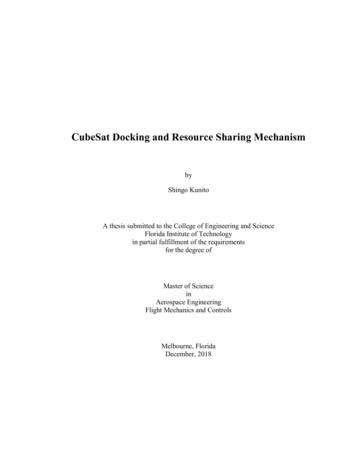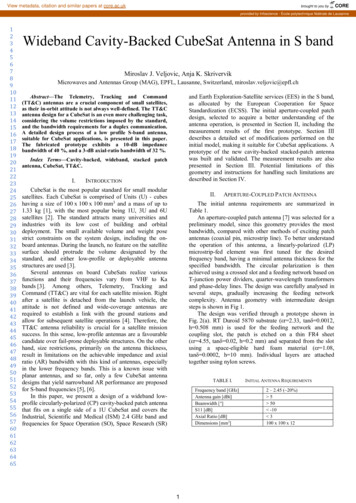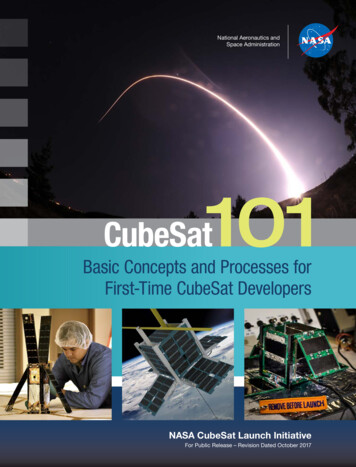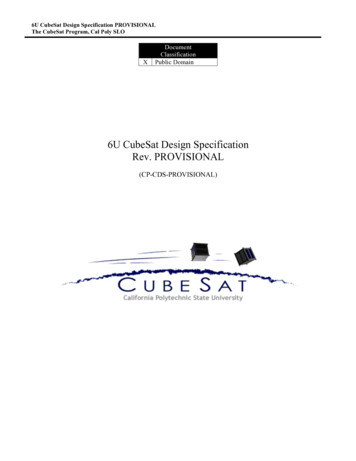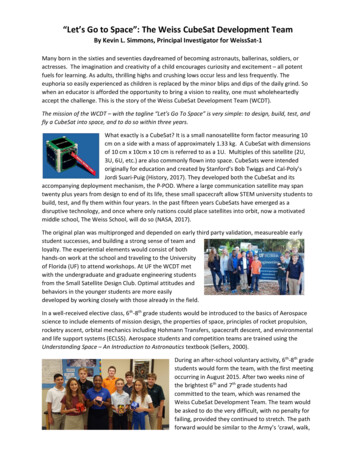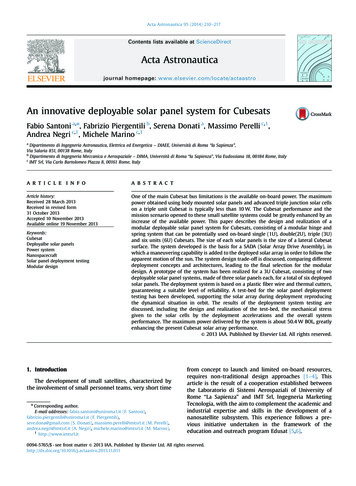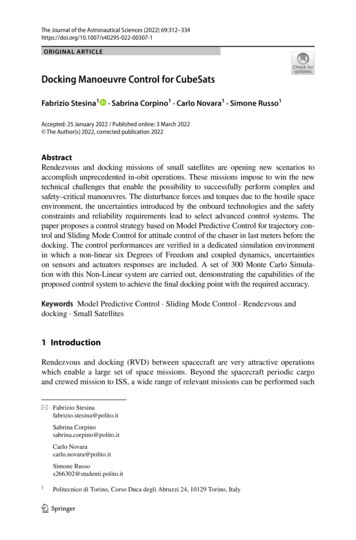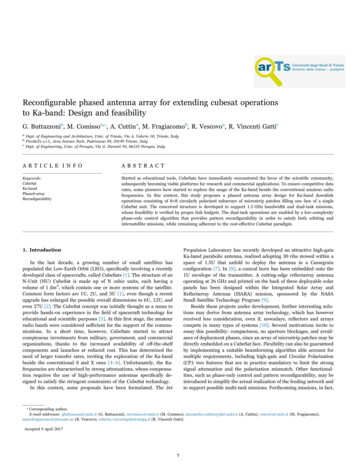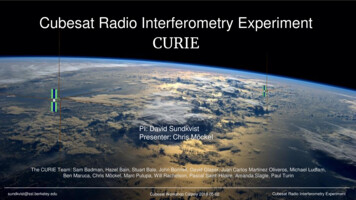
Transcription
Key pointsCURIECubesat Radio Interferometry ExperimentCURIEKey science ImplementationPI: David SundkvistPresenter: Chris MöckelThe CURIE Team: Sam Badman, Hazel Bain, Stuart Bale, John Bonnell, David Glaser, Juan Carlos Martinez Oliveros, Michael Ludlam,Ben Maruca, Chris Möckel, Marc Pulupa, Will Rachelson, Pascal Saint-Hilaire, Amanda Slagle, Paul ley.eduCubesatWorkshopCalpoly mentExperiment
Key Points of the CURIE MissionCURIECUbesat Radio Interferometry Experiment - CURIE First path-finder mission for future low frequency interferometer observatory in space. Low frequency observations (0.1 - 40 MHz). Two Cubesats flying in formation in Low Earth Orbit, with a few km separation. Built and operated from Space SciencesLaboratory (SSL) / UC Berkeley. Scientists, engineers, students. Student participation at all stages of the mission. Funded by NASA (4 year program). Heliophysics Technology and Instrument Developmentfor Science (HTIDS/LCAS).sundkvist@ssl.berkeley.eduCubesat Workshop Calpoly2018-05-02Cubesat Radio Interferometry Experiment
CURIESpace Sciences Laboratory / UC BerkeleySPACE SCIENCES LABORATORY (SSL)(UC Berkeley Organized Research Unit)Long list of missions.Some Previous Flight SystemsCHIPS (UNEX)EUVEBackground Initiated in 1958 by Struve, Teller and Seaborg Multi-disciplinary laboratory Space and suborbital research and training Facility opened in 1966 (NASA CoE) New facilities added in 1998Research Efforts Involving Balloons (GRIPS, NCT, etc) Sounding rockets (FOXSI, GREECE, TRICE-2) Cubesats (CINEMA, CURIE) Satellite instruments & science complements Complete satellites & multi-satellite missions Mission & Science Operations Education and Public OutreachAgencies Involved NASA, NSF, NSBF, USAF, DOE, MBRSC ESA, JAXA, IKI, KARI, PSI, etc. 80-90M/yr ( 90% NASA, 10% other.)FAST (SMEX)Polar EFIImage FUV, WIC,Mars Global Surveyor ERLunar Prospector ERROCSAT 2 – ISUALUlysses LAN, HURFUSEKITSAT SPEAROperational Flight SystemsTHEMIS (MIDEX)RHESSI (SMEX)Wind 3DPCluster II EFW, CISSOHO UVCS & SUMERSTEREO – IMPACT, S/WAVESHUBBLE – COSNuSTARRBSP EFWMAVEN Particles and Fields Suite (2013)Under DevelopmentSolar Probe Plus (2018)ICON (2017) and GOLD, Litebird MoO Phase ABalloons and rockets and Cubesats (CURIE)sundkvist@ssl.berkeley.eduCubesat Workshop Calpoly2018-05-02Cubesat Radio Interferometry Experiment
SSL FacilitiesCURIE Research & Design 400 Scientists (4 Nobelists), Engineers, Students, Staff 55000 sq. ft. Office and Laboratory Space Machining & Production On-site Machine shop Integration Clean Room Facilities to Class 100 4-story High BayBerkeley Ground StationOffice and Lab Space Testing facilities Vibration table Thermal Vacuum Facilities up to 3m diameter Radiation Sources Laboratory Operation Mission Operations Center Science Operations Centers 11 Meter S-Band / UHF Satellite Antenna Secure Communications to NASAsundkvist@ssl.berkeley.eduTHEMIS in SSL cleanroomCubesat Workshop Calpoly2018-05-02Missions Operations CenterCubesat Radio Interferometry Experiment
Science Objectives OverviewCURIE (Primary)Radio interferometric observations of radio burst emissions fromsolar eruptive events. Coronal mass ejections/shocks - Type II radio bursts. Flares - Type III radio bursts.Type IIIType II (Secondary)Ionospheric measurements (in-situ) of electron density and temperature. Density gradients on the scale of a few km (spacecraftdistance, 400-1100 km orbit).Synthesis imaging Create a map of the radio sky at frequencies below the ionospheric cut-off.All science objectives addressed using the same data set.sundkvist@ssl.berkeley.eduCubesat Workshop Calpoly2018-05-02Cubesat Radio Interferometry Experiment
Radio SourcesCURIE Lowest frequencies cut-off by the ionosphere.- Need space based measurements. CURIE’s primary frequency range: 0.1-40 MHz. Low Earth Elliptical Orbit, compromise between Science (high apogee) OperationsCURIE(1 ms x 1 MHz)CURIE(1 s x 1 MHz)CURIE(1 h x 1 MHz)CURIEIonospheric cut-off frequencysundkvist@ssl.berkeley.eduCubesat Workshop Calpoly2018-05-02Cubesat Radio Interferometry Experiment
Radio SourcesCURIE Lowest frequencies cut-off by the ionosphere.- Need space based measurements. CURIE’s primary frequency range: 0.1-40 MHz. Low Earth Elliptical Orbit, compromise between Science (high apogee) OperationsCURIE(1 ms x 1 MHz)CURIE(1 s x 1 MHz)CURIE(1 h x 1 MHz)CURIEIonospheric cut-off frequencysundkvist@ssl.berkeley.eduCubesat Workshop Calpoly2018-05-02Cubesat Radio Interferometry Experiment
CURIERadio Interference in LEO (STEREO Measurements)Spectral t@ssl.berkeley.edu25 kHz9 kHz1 kHzSTEREO-A (RFI masked)Cubesat Workshop Calpoly2018-05-02Cubesat Radio Interferometry Experiment
InterferometryCURIE Two-element interferometer makes possible: Interferometric direction finding 2–3 arcmin or better, depending on projected baseline(spacecraft separation vector) and SNR. Source size determination (Gaussian) 1-3kmCURIE can sample the 30 arcmin (at 10 MHz)angular source size typical of solar Type II and Type IIIbursts at 1 AU.Imaging of static radio sourcesBasic observables: correlated amplitude andrelative phase (spatial coherence function)CMESun Four or more CURIE Cubesats would allow snapshot imaging oftransient events.sundkvist@ssl.berkeley.eduCubesat Workshop Calpoly2018-05-02Cubesat Radio Interferometry Experiment
CURIE Instrument HeritageCURIEParker Solar Probe The CURIE instrument is derivative of thePSP/FIELDS radio frequency spectrometer(currently TRL 7, soon TRL 8). Launch in July 2018 (recommended byNASA/NRC for 30 years) NASA Heliophysics ‘Living with a Star’ Mission Perihelion at 9.8 solar radii Primarily in situ instrumentssundkvist@ssl.berkeley.edu CURIE is using deployable stacer antennaspreviously built by SSL and used on STEREO,THEMIS, POLAR and FAST.Cubesat Workshop Calpoly2018-05-02Cubesat Radio Interferometry Experiment
Instrument Heritage and DevelopmentInstrumentCURIECURIE-RFS is a digital radio spectrometer based on PSP/FIELDS:Leverages heritage / development. Improved absolute time to few ns chip-scale atomic clock. Improved frequency resolution (1 kHz) Redesign of the PSP/FIELDS instrument Added frequency channel Antennas in three dimensions allows polarizationmeasurements.FPGA daughterboardAnalog t Workshop Calpoly2018-05-02Cubesat Radio Interferometry Experiment
Spacecraft designCURIEMain stack 1InstrumentOBCS-band transmitterGlobalstar modemUHF transceiverGPSStar TrackerThrusterEPSStacer antennasPreamplifiersAnalog Interface BoardDigital Interface BoardAtomic Clock BoardGPSCURIE will launch as a 6U and separate into two 3UCubesats once in orbit.sundkvist@ssl.berkeley.eduCubesat Workshop Calpoly2018-05-02Cubesat Radio Interferometry Experiment
Spacecraft designADCSconcept/ OrbitCURIE Three axis stabilizedAttitude and position knowledge: Star tracker Magnetometer GPS Photo diodesAttitude control: Torque coils Reaction wheel (z-axis) Cold gas thruster (z-axis)Orbit control: 400 - 1100 km, inclination 27 - 45 (ideal) Spacecraft separation: 1 - 3 km (science dictates knowledgemore important than exact control) In-house developed combined attitude controller / orbitpropagator Separation control using both thruster and differential drag. Drag important around perigee.sundkvist@ssl.berkeley.eduCubesat Workshop Calpoly2018-05-02Cubesat Radio Interferometry Experiment
on: attitude stabilized with a pointing controller using a z-axis reaction wheeland torque coils. Different orientation leads to differential drag, increasing separation.sundkvist@ssl.berkeley.eduCubesat Workshop Calpoly2018-05-02Cubesat Radio Interferometry Experiment
Hardware Development StatusCURIEIn-house development status Comms Antennas Instrument Preamplifiers (built) Analog Interface Board (layout) Digital Interface Board (layout) Stacer Antennas (preparing order) EMC/EMI noise environment testing (bench testing)S-band patch (simulated,built, testing) Dedicated Cubesat Groundstation (separatefrom SSL/BSG/MOC Antennas (field testing) Solar Panels Mechanical/Electrical Design (rev A done). Hinges / PCB (fabrication). Bus Mechanical design (done, not fabricated) 6U attachment and separation mechanism design (done,not fabricated) Torque rods Testing core materials Magnetometer (magnetoresistive) Bench testingsundkvist@ssl.berkeley.eduCubesat Workshop Calpoly2018-05-02Cubesat Radio Interferometry Experiment
SummaryCURIECubesat Radio Interferometry Experiment - CURIE First path-finder mission for future low frequency interferometer observatory in space. Low frequency observations (0.1 - 40 MHz). Two Cubesats flying in formation in Low Earth Orbit, with a few km separation. Built and operated from Space Sciences Laboratory (SSL) / UC Berkeley. Funded by NASA (4 year program). Heliophysics Technology and Instrument Developmentfor Science (HTIDS/LCAS). The future Larger array (more Cubesats): Imaging of transient events Dark side of the moon to observe early Universe(redshifted H, He), epoch of re-ionization.sundkvist@ssl.berkeley.eduCubesat Workshop Calpoly2018-05-02Cubesat Radio Interferometry Experiment
sundkvist@ssl.berkeley.edu Cubesat Workshop Calpoly 2018-05-02 CURIE Cubesat Radio Interferometry Experiment 1 Spacecraft design CURIE will launch as a 6U and separate into two 3U Cubesats once in orbit. Main stack OBC S-band transmitter Globalstar modem UHF transceiver GPS Star Tracker Thruster EPS Instrument Stacer antennas Preamplifiers
